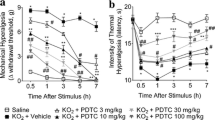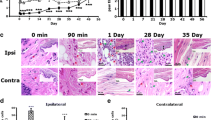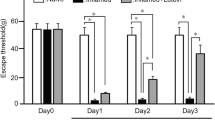Abstract
Reactive oxygen species, including hydrogen peroxide (H2O2), are released from activated leucocytes and resident cells in the joint during inflammation. We hypothesize that H2O2 is an important mediator of inflammatory pain and, thus, the aim of our experiments was to investigate the effect of H2O2 on inflammation of the mouse hindpaw. We performed behavioural studies in CD1 mice to determine the effect of H2O2 on both thermal and mechanical hyperalgesia and oedema formation 20 minutes after intraplantar injection into the mouse hindpaw. The Hargreaves technique was used to test thermal hyperalgesia and a dynamic plantar aesthesiometer was used for mechanical hyperalgesia studies. Oedema was determined by measuring paw mass. Our experiments showed intraplantar injection of H2O2 (2200–8800 nmoles) causes significant thermal and mechanical hyperalgesia of the mouse hindpaw. H2O2 also causes significant oedema formation. Thus, we propose that H2O2 is a potential target for the treatment of inflammatory pain.
Similar content being viewed by others
References
Hitchon CA and El-Gabalawy HS. Oxidation in rheumatoid arthritis. Arthritis Res Ther 2004; 6: 265–78.
Khattab MM. TEMPOL, a membrane-permeable radical scavenger, attenuates peroxynitrite- and superoxide anionenhanced carrageenan-induced paw edema and hyperalgesia: a key role for superoxide anion. Eur J Pharmacol 2006; 548: 167–73.
Kress M, Riedl B and Reeh PW. Effects of oxygen radicals on nociceptive afferents in the rat skin in vitro. Pain 1995; 62: 87–94.
Hargreaves K, Dubner R, Brown F, Flores C and Joris J. A new and sensitive method for measuring thermal nociception in cutaneous hyperalgesia. Pain 1988; 32: 77–88.
Schraufstatter IU, Hyslop PA, Hinshaw DB, Spragg RG, Sklar LA and Cochrane CG. Hydrogen peroxide-induced injury of cells and its prevention by inhibitors of poly(ADPribose) polymerase. Proc Natl Acad SciUSA 1986; 83: 4908–12.
Cai H. Hydrogen peroxide regulation of endothelial function: origins, mechanisms, and consequences. Cardiovasc Res 2005; 68: 26–36.
Pearse DB, Shimoda LA, Verin AD, Bogatcheva N, Moon C, Ronnett GV, Welsh LE and Becker PM. Effect of cGMPon lung microvascular endothelial barrier dysfunction following hydrogen peroxide. Endothelium 2003; 10: 309–17.
Author information
Authors and Affiliations
Corresponding author
Rights and permissions
About this article
Cite this article
Keeble, J.E., Bodkin, J.V., Russell, F.A. et al. A role for hydrogen peroxide in inflammatory hyperalgesia of the mouse hindpaw. Inflamm. Res. 56 (Suppl 3), S492–S494 (2007). https://doi.org/10.1007/BF03353887
Published:
Issue Date:
DOI: https://doi.org/10.1007/BF03353887




